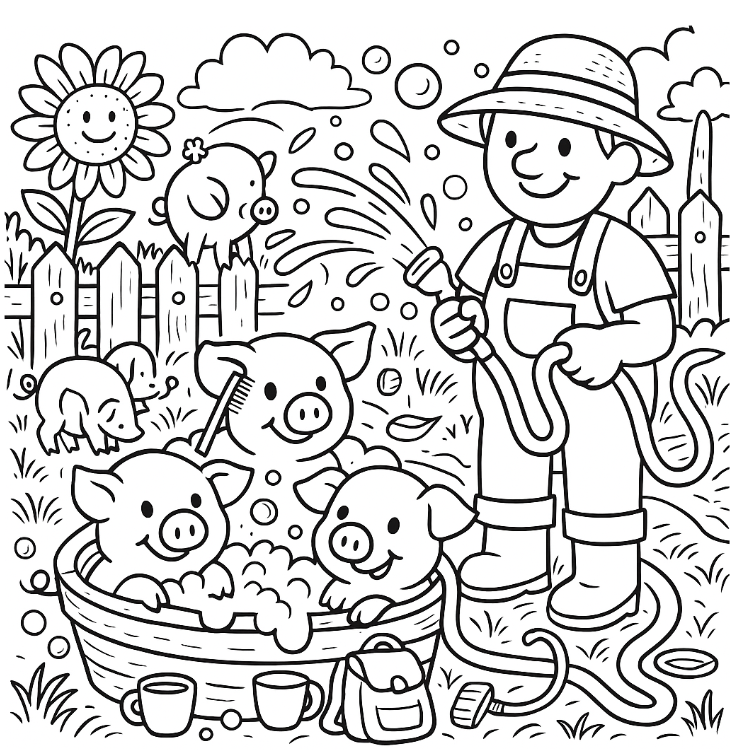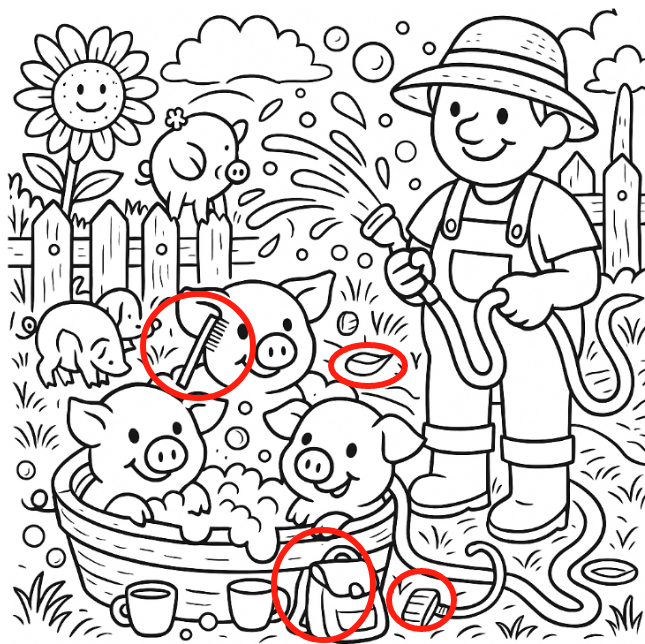Splash into Piglet Bath Time: Farm Hygiene, Animal Welfare, and Fun Tips
Why Bathing Piglets Matters on the Farm
Have you ever watched adorable piglets squealing with delight (or surprise) as they splash in water? Beyond the cuteness factor, washing piglets plays an important role in farm hygiene and animal welfare. Clean piglets are healthier piglets: regular baths help remove dirt, parasites, and excess oils that can irritate their skin. Plus, a gentle bath session builds trust between farmer (or caretaker) and animals, strengthening bonds and making handling easier down the road. If you’re curious about how to turn piglet bath time into a positive, stress-free routine, read on. We’ll dive into why piglet bathing matters, how to do it safely, and fun ways to involve kids or farm visitors. Ready to get splashing? Let’s go!

Understanding Piglet Skin and Hygiene Needs
Piglets’ skin differs from humans’: it’s sensitive, prone to dryness or irritation if cleaned improperly. On the other hand, piglets love wallowing in mud or rooting around, which can leave them covered in grime and potential external pests. Regular cleaning helps prevent skin infections, mange mites, or flystrike in hot months. But how often should you bathe them? It depends on your climate and farm setup. In muddy conditions, a gentle wash after the mud dries can prevent buildup. However, over-bathing risks stripping natural oils. The goal: find a balance that maintains cleanliness without stressing their skin. Observing piglets’ behavior—scratching, skin redness, or discomfort—signals when a bath might help. By understanding these needs, you approach bath time not as a chore but as attentive care.
Choosing the Right Supplies for a Safe Piglet Bath
Before grabbing the hose, let’s gather essentials. First, use lukewarm water—piglets can chill easily or find hot water unpleasant. A gentle flow from a hose or bucket helps control splash. Next, select a mild, animal-safe shampoo or soap formulated for pigs or sensitive livestock skin; avoid harsh detergents that strip protective oils. You’ll also need a soft brush or sponge to scrub gently, removing dirt without irritating. A non-slip tub or shallow container keeps piglets secure—plastic tubs or troughs lined with a textured mat work well. Have clean towels or absorbent cloths on hand for drying, plus a warm, draft-free area where piglets can shake off water and warm up. Finally, consider treats: small pieces of fruit or safe piglet snacks can distract them during the bath and associate cleaning with positive rewards. By preparing thoughtfully, bath time becomes smooth and stress-free for both you and the piglets.

Step-by-Step Guide to Washing Piglets Safely
- Prepare the Area: Choose a calm spot on level ground, away from loud noises or sudden disturbances. Lay out your tub or container and pre-fill with lukewarm water about ankle-deep for a small piglet (adjust depth so they can stand comfortably without feeling submerged).
- Gather Piglets Gently: Approach slowly, using a calm voice. Scoop or guide them gently into the tub—avoid sudden movements that may startle them. If you have multiple piglets, wash one at a time or in small groups to ensure individual attention.
- Wet and Lather: Using a cup or hose on gentle spray, wet the piglet’s body, avoiding eyes and ears. Apply a small amount of mild shampoo, gently massaging in circular motions. Focus on areas prone to dirt: underbelly, legs, and creases. The goal is a thorough yet gentle clean.
- Rinse Thoroughly: Ensure all soap residue is washed off; leftover soap can irritate skin. Keep water temperature comfortable, and use soft pressure so piglets feel secure.
- Dry and Warm: Lift the piglet from the tub and wrap it in a towel. Gently pat dry, especially underbelly and legs. If weather is cool, place piglets in a warm, draft-free pen or under a heat lamp until fully dry.
- Reward and Observe: Offer a treat or gentle scratch, praising the piglet for calm behavior. Observe their skin for any redness or irritation. If you notice issues, note them for future care or consult a vet if needed.
- Clean Up: Drain and clean the tub promptly to remove dirt and soap. Rinse brushes and towels, and store supplies in a clean, dry place. Proper cleanup prevents bacteria buildup and readies you for the next bath.
Creating a Stress-Free Bath Environment
Piglets pick up on your mood and surroundings. To keep bath time positive:
- Use Calm, Consistent Cues: Speak softly, use familiar phrases or whistles to signal bath time, so piglets know what to expect.
- Minimize Sudden Noises: Avoid clanking metal or abrupt splashes that might spook them.
- Play Gentle Music or Natural Sounds: A quiet background track can soothe both you and animals.
- Incorporate Playful Distractions: Floating toys or safe objects can engage curious piglets, turning bath into a mild enrichment session.
- Maintain Routine: When possible, bathe at similar times of day so piglets anticipate a gentle cleaning ritual. Rituals breed comfort.
- Monitor Temperature and Weather: On hot days, a quick cool rinse can feel refreshing; in cooler weather, ensure swift drying and warmth.
By crafting a calm, predictable environment, you reduce piglets’ stress, making future baths smoother and building trust.

Benefits of Piglet Baths: Health, Bonding, and Enrichment
Beyond cleanliness, piglet baths offer multiple perks:
- Improved Skin Health: Removing dirt and parasites reduces disease risk and itchiness.
- Enhanced Human-Animal Bond: Gentle handling and positive associations (treats, praise) foster trust, easing future handling for vaccinations or health checks.
- Behavioral Enrichment: Piglets love exploration; bath time introduces new textures and sensations, stimulating their curiosity.
- Cooling in Summer: A light wash helps piglets regulate body temperature when heat intensifies.
- Early Socialization for Kids or Visitors: Supervised, interactive bath sessions can educate children on animal care, instilling compassion and responsibility.
By highlighting these benefits, you see piglet baths as a holistic care practice, not just a hygiene task.
Integrating Bathing into Routine Farm Care
How often should you bathe piglets? It varies: in muddy seasons, you might clean them weekly or as needed; in drier periods, less frequently. Incorporate bath checks into regular health inspections: while washing, observe overall condition—weight, skin, eyes, mobility. Combine bath time with hoof trimming or basic grooming to maximize handling efficiency. Keep records: note date, observations, and any skin issues to track patterns. If piglets are part of a breeding program, start baths early so they become accustomed to handling, simplifying future procedures. For small-scale or homestead farms, involve family members or helpers in the routine, rotating responsibilities to share knowledge and workload. Integrating baths into a broader care plan ensures consistency and comprehensive welfare.

Involving Kids and Visitors: Educational and Fun Experiences
Farm visits can delight children and novices. Bathing piglets becomes an educational highlight:
- Hands-On Learning: Under supervision, kids can help fill the tub, gently lather a piglet’s back (with guidance), and offer treats after. They learn about animal needs, empathy, and responsibility.
- Storytelling and Themes: Frame bath time around a playful story—“Pig Spa Day” or “Bubble Party for Piglets”—to spark imagination.
- Arts and Crafts Tie-Ins: After washing piglets, children can draw or color pictures of pigs enjoying a bubble bath, reinforcing the experience.
- Photo Ops and Social Sharing: Capture supervised snapshots (respecting piglet comfort) for farm social media, showcasing humane farm practices and attracting community interest.
- Safety and Hygiene Education: Teach simple biosecurity: washing hands before and after, cleaning tools properly. These lessons extend to broader health awareness.
By making piglet baths a community-friendly activity, you share best practices, foster appreciation for thoughtful animal care, and potentially attract supportive farm volunteers or customers interested in ethical farming.
Eco-Friendly Considerations and Water Use
While baths benefit piglets, consider water conservation:
- Reuse Wash Water for Plants: If free of harsh chemicals, slightly soapy water can water non-edible plants or trees, recycling nutrients.
- Use Biodegradable Soap: Select eco-friendly shampoos that break down safely, minimizing environmental impact.
- Collect Runoff: Position the tub or bath area near soil beds that tolerate gentle washing. Prevent runoff from contaminating water bodies.
- Limit Frequency: Only bathe when necessary; occasional spot-cleaning certain areas can reduce water use.
Balancing piglet hygiene with sustainable practices ensures farm operations respect natural resources while maintaining animal welfare.

Handling Challenges and Veterinary Advice
Sometimes bath time reveals skin issues: redness, scabs, or unusual parasites. If you spot concerns, consult a veterinarian promptly. They can recommend medicated shampoos or treatments suited to piglets. For very young or weak piglets, be extra cautious: limit bath duration and ensure they stay warm. In dire mud or heavy parasitic loads, pre-soaking areas with a gentle spray before full bath can help loosen dirt. If piglets strongly resist water, try acclimating them gradually: start with damp cloth wipes, then shallow dips. Patience and positive reinforcement are key. Always prioritize piglet comfort and safety; if unsure, seek expert guidance rather than forcing a stressful bath.
Conclusion: Embrace Piglet Bath Time as Holistic Care
Washing piglets may seem like a niche chore, but when approached thoughtfully, it becomes a cornerstone of farm hygiene, animal welfare, and community engagement. From understanding piglet skin needs and choosing gentle supplies to crafting stress-free environments and involving kids, bath time evolves into a meaningful ritual. Beyond cleanliness, piglet baths foster bonding, stimulate enrichment, and educate visitors on compassionate farm practices. By integrating eco-friendly water use and consulting vets when needed, you balance animal health with sustainability. So next time muddy piglets squeal with excitement (or mild protest) at bath time, lean in with warmth, treats, and gentle handling. You’ll emerge with healthier animals, stronger human-animal connections, and the satisfaction of caring for your farm’s tiniest members in the most delightful way. Happy splashing!